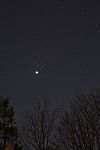
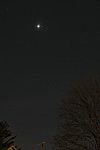 NEW!!
Photos by Steve Luzader.
NEW!!
Photos by Steve Luzader. Venus and the Pleiades on April 2 - 3, 2012. The left-hand image was taken at about 8:20 PM on April 2 in Brockton, MA. The right-hand image was taken around 9:30 PM on April 3 in Frostburg. Both images were taken with a Canon 40D DSLR with an 19 - 50 mm lens set for 50 mm focal length. The April 2 exposure was 2 seconds at f2.8, ISO 800. The April 3 exposure was 2 seconds at f4, ISO 1250.
 Photo by Steve Vincent.
Photo by Steve Vincent. Venus and Jupiter on March 14, 2012. The photo was taken at about 8:15 PM EDT from Steve's home in Bittinger. The digital camera exposure was 16 s at f2.8, ISO200 (focal length not specified). The flash was triggered at the end of the exposure to illuminate the tree branches in the foreground. Note the Pleiades at the top of the image.
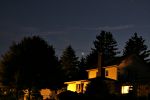 Photo by Steve Luzader.
Photo by Steve Luzader. Venus, Saturn, and Mars on August 1, 2010. The photo was taken from my front yard in Frostburg. The three planets are the brightest points in the image, forming a long triangle with Venus at the lower vertex and Saturn at the upper vertex. The magnitude 3.8 star Savijah in Virgo can be seen between Venus and the other two planets. The picture was taken with a Canon 40D SLR fitted with a 17- 50 mm lens set for 50 mm at f4, ISO 1600. The exposure was 2 sec.
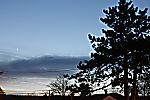 Photos by Steve Luzader.
Photos by Steve Luzader. Photos of Venus and Mercury on April 7 and 10, 2010. The 4/7 photo was taken from the street near my house in Frostburg, and the 4/10 photo was taken at CAC President Steve Vincent's house in Bittinger, near Grantsville. Both pictures were taken with a Canon 40D SLR fitted with a 17- 50 mm lens set for 50 mm at f4. The ISO setting was 1600. The exposures were 0.3 sec on 4/7 and 1 sec on 4/10.
 Photo by Steve Luzader.
Photo by Steve Luzader.
A photo of the auroral display on Thursday evening, October 30, 2003. This photo
shows the Pleiades amid shimmering curtains. The exposure was about 15 seconds
on Fuji ASA 800 film with a 50 mm lens at f/2.
 Photos
by Steve Luzader.
Here are two of the 12 photos I took of the auroral display early Wednesday
evening, October 29, 2003. These pictures were taken around 8 PM EST. The first
is looking east over the top of our house. The second is looking south and shows
Mars framed by the aurora. The exposures were about 15 seconds on Fuji ASA 800
film with a 28 mm lens at f/2.8.
Photos
by Steve Luzader.
Here are two of the 12 photos I took of the auroral display early Wednesday
evening, October 29, 2003. These pictures were taken around 8 PM EST. The first
is looking east over the top of our house. The second is looking south and shows
Mars framed by the aurora. The exposures were about 15 seconds on Fuji ASA 800
film with a 28 mm lens at f/2.8.
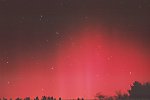 Photo by Gus Johnson.
Photo by Gus Johnson.
A spectacular photo of the aurora of October 28, 2000 as seen at Herrington
Manor State Park. The exposure was 10 seconds on Kodak ASA 400 color
negative film using a 50 mm lens and f/1.9. The bowl of the Big Dipper
is visible at the lower left of the image.
 Photo by Gus Johnson.
Photo by Gus Johnson.
This is a photo of the attractive rectangle formed by the Pleiades, Saturn, Jupiter, and Aldebaran in the fall of 2000. The fixed tripod photo was taken at about 5:30 AM on Sept. 30, 2000. The exposure was 22 sec with a 50 mm lens at f/1.9 on Fujicolor 800 film.
 Photo by Steve Luzader
Photo by Steve Luzader I went on out Oct. 28, 2000, to take a photo like the one above by Gus Johnson. Ordinarily we would try to avoid duplication, but Gus called me a few days later and asked if I had seen the aurora on the 28th. I hadn't noticed it because I was glued to my telescope taking photos. However, when the film was processed I found that I had accidentally captured part of the auroral glow in my fixed tripod photo of Jupiter, etc. The exposure was 20 seconds with a 50 mm lens at f/2 on Fujicolor 800 film.
 Photo
by Gus Johnson
Photo
by Gus Johnson
Scorpius over the new Discovery Center at Deep Creek State Park in western Maryland. Antares is the blazing red star near the upper right corner of the image. 19 sec exposure on Fuji 800 color negative film with a 50 mm lens at f/1.9. The globular cluster M4 is barely visible to the west (right) of Antares. The open cluster M6 can be seen about a fifth of the way from the left side of the image, while the much larger open cluster M7 is easily visible about 1/6 of the way from the left edge.
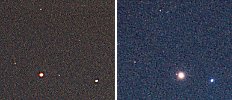 Photos
by Steve Luzader
Photos
by Steve Luzader
In May and June of 1999, Mars was close to Spica in the constellation
Virgo. In the two thumbnail images, Spica is seen near the lower right
corner and Mars is near the lower center of each image. Spica and three
other stars in Virgo form a right triangle that can be used as a reference
to follow the motion of Mars. The left image was taken on May 19 and the
right image was taken on June 13. Note how Mars has moved relative to the
triangle of stars. Clicking on the thumbnails will bring up a large collection
of images taken on many nights from May 19 through June 13. Mars ends its
retrograde motion by looping around the star 76 Virginis, located in the
middle of the base of the triangle. All exposures were about 10 seconds
on Kodak Gold 800 film with a 50 mm lens set at f/2. Click here
for more details.
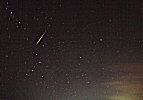 Photo
by Amber Stuver
Photo
by Amber Stuver
One of the Leonid meteors passing Cassiopeia in the early morning hours of Nov. 17, 1998. The exposure was 1 minute on Kodak Gold 800 color negative film using a 28 mm lens at f/1.9.
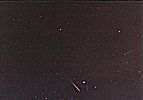 Photo
by Amber Stuver
Photo
by Amber Stuver
A Leonid meteor flashing past Sirius, with Orion farther to the right.
This fixed tripod photo was taken between 3 AM and 5 AM on Nov. 17, 1998.
The exposure was 45 seconds on Kodak Gold 800 color negative film using
a 28 mm lens at f/1.9.
 Photo
by Charles Plauger
Photo
by Charles Plauger
Star trails photographed looking north from S. Luzader's driveway.
This picture was made as part of a Senior Lab project at Frostburg State
University. A 40 minute exposure was made with a 55 mm lens at f/5.6 on
Ektachrome 400 slide film.
 Photo
by Steve Luzader
Photo
by Steve Luzader
Star trails photographed looking north from Cabin 6 at Blackwater Falls State Park in West Virginia. This 2-hour exposure was made with a 28 mm lens at f/4 on Fujichrome Sensia 100 slide film. The photo was taken on March 24, 1998.
 Photo
by Steve Luzader
Photo
by Steve Luzader
Star trails photographed looking south from Cabin 6 at Blackwater Falls State Park in West Virginia. This 2-hour exposure was made with a 28 mm lens at f/4 on Fujichrome Sensi 100 slide film on March 26, 1998. Note the opposite curvature of the trails above and below the celestial equator, which runs from about one quarter of the way down from the top on the left side of the image to the upper right corner on the opposite side. (Note: The dashed appearance of the trails is a scanning artifact.)
 Photo
by Gus Johnson
Photo
by Gus Johnson
This photo was taken at 3:42 AM on March 13, 1992, when a nova was
visible in Cygnus. The nova is indicated with two black marks just above
and to the left of the center of the image. The North America Nebula is
visible just above the trees near the bottom center of the picture. The
fixed tripod exposure was 18 seconds with a 50 mm lens at f/1.9 on Fujicolor
1600 color negative film.
 A
sketch identifying the important features of the photo above.
A
sketch identifying the important features of the photo above.
 Photo
by Gus Johnson
Photo
by Gus Johnson
Sometimes an astrophotograph doesn't look like one at first. This is
a picture of Deep Creek Lake in far western Maryland on the evening of
Feb. 1, 1989. The lights of the Wisp ski slope are glowing brightly and
are reflected in the water of the lake. The star Sadr of Cygnus is just
above the trees on the right side of the picture, and its reflection is
seen in the water. Below the reflection of Sadr is a brighter reflection
of the star Deneb, which is too high to be seen in the top of this image.
This was a 20 second exposure on ASA 400 film with a 50 mm lens at f/1.9.
 Photos
by Steve Luzader
Photos
by Steve Luzader
This is a composite of a series of exposures taken on nearly successive nights in May 1995 as Mars passed Regulus. (The thumbnail only includes two frames.) Each night at about 8 pm, the camera was positioned so that Regulus was in the center of the frame, and a 10-second exposure was made on Fujichrome 100 slide film with a 55 mm lens set at f/2. The individual slides were scanned and assembled into the single image shown here. Regulus is at the bottom of each image, and Mars is in the top. From the left, the dates are May 21, 22, 24, 25, 26, 30. (The missing nights were due to rain or clouds.) Notice how Mars is moving east relative to Regulus--this eastward motion is one of the characteristics that distinguished planets from stars to ancient astronomers.
 Photo
by Steve Luzader
Photo
by Steve Luzader
This fixed tripod picture of the crescent moon and Venus was made with a 55 mm lens at f/2 with an exposure time of 1 second on Fujichrome Sensia 100 film. The picture was taken at about 9:35 pm on July 7, 1997. I had to carry the camera and tripod several blocks to find a place where the view of these celestial objects wasn't blocked by trees.
 Photo
by Steve Luzader
Photo
by Steve Luzader
This is a grouping of the moon, Mars, and Spica photographed at 9:33 PM EDT on July 11, 1997. The exposure was 2 seconds with a 55 mm lens at f/2.8 on Ektachrome 400 slide film. Mars is just beside the moon, and Spica is farther to the south (left in the photo).
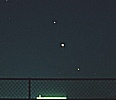 Photo
by Steve Luzader
Photo
by Steve Luzader
A photo of Mars, Venus, and Antares on October 19, 1997. The picture was taken at 7:35 pm on the campus of Frostburg State University. The exposure was 15 seconds on Fujichrome Sensia 200 slide film with a 55 mm lens set at f/2.8. Part of this frame is in the sequence of images below.
 Photos
by Steve Luzader
Photos
by Steve Luzader
This is a composite of a series of exposures taken on nearly successive nights in October 1997 as Venus and Mars moved relative to Antares. Exposures were taken from the same spot behind Tawes Hall on the FSU campus at about 7:30 pm. Each exposure was about 15 seconds on Fujichrome Sensia 200 slide film with a 55 mm lens at f/2.8. The camera was positioned so that the Mars-Venus-Antares grouping was centered in the viewfinder. The individual slides were scanned, the center part cropped out, and the cropped images were assembled into the montage shown here. Mars is at the top of the threesome, bright Venus is in the middle, and Antares is at the bottom. On each successive night, Mars and Antares moved toward the west and got lower in the sky, while Venus moved up and towards the east. The westward motion of Mars is an example of retrograde motion. The missing nights (including 10/18/97, when the three bodies were in a straight line) were due to clouds or rain.
 Photo
by Steve Luzader
Photo
by Steve Luzader
The thumbnail picture shows a photo of Jupiter, Venus, and Mars taken at 6:10 PM EST on 11/25/97. Clicking on the thumbnail will show a composite of two images. One is a larger version of the thumbnail, and the other is a photo taken by moving the camera along the ecliptic until it was pointed nearly overhead. The image then shows Jupiter and Saturn at opposite corners of the frame, with Jupiter at the lower right. The exposures were about 30 seconds on Fujichrome Sensia 200 slide film using a 28 mm lens at f/4. (Note: Earlier that evening, Mercury was also visible. I tried photographing this rare alignment of all five naked-eye planets, but alas the slides were all overexposed!)
 Photo
by Steve Luzader
Photo
by Steve Luzader
A photo of the moon and Jupiter taken about 6 PM EST on New Years Day, 1998. The camera was attached to my 80 mm f/5 Orion "Shorttube" refractor mounted on a camera tripod. The exposure was 1 second on Fujichrome Sensia 100 slide film. Earthshine is barely visible on the dark part of the moon.
